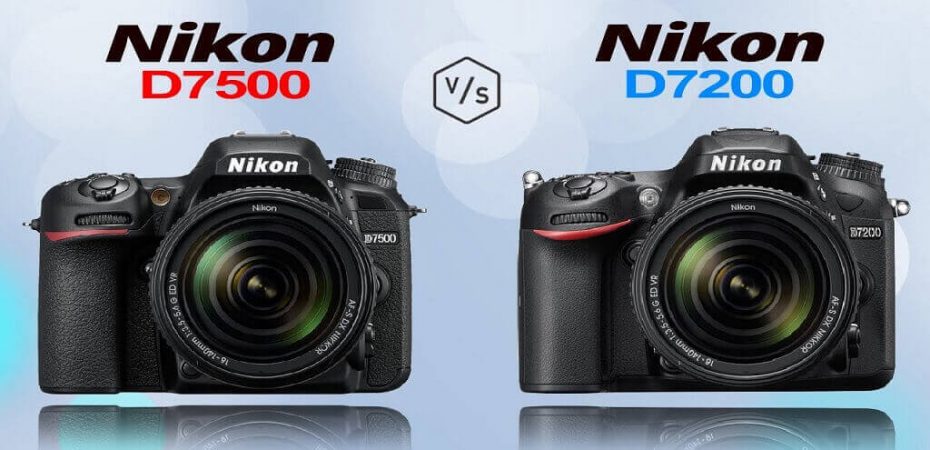In 2017, the camera manufacturing giant Nikon announced the D7500 – a much-anticipated update of the company’s best-selling prosumer level camera, D7200. At the time of the D7500’s launch of the D7500, D7200 was already two years old, and the market was expecting the D7500 to have multiple improvements.
Now, after 3 years since D7500’s launch, we examine whether D7500 delivered the upgrades that warrant a purchase even today, or should you stick with the old favorite D7200.
In today’s comparison review, we put the D7500 head to head with the D7200 to find out the superior offering from Nikon for budding professional photographers.
Nikon D7200 vs D7500: Sensor
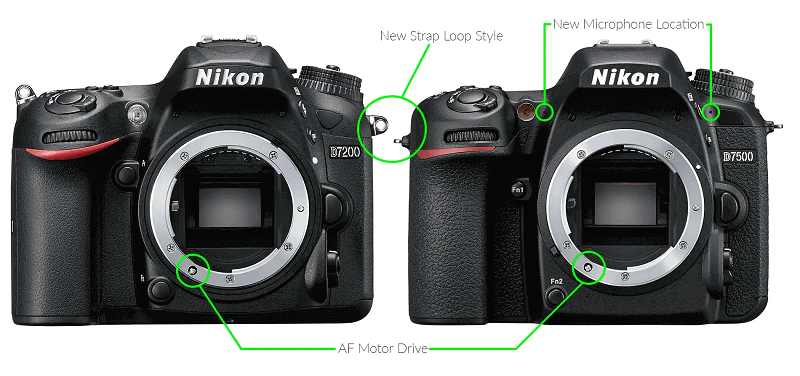
The D7200 had a 24MP APS-C DX-format sensor, although the D7500 was given the same DX-format chip sensor, it brought down the resolution to 20.9MP, which meant fewer pixels, but the difference was negligible. Nonetheless, the D7500 provided a more flexible ISO range, an acceptable tradeoff for the pixel reduction.
D7200 ISO range is 100-25,600, while the D7500 range goes up to 51,200. Additionally, the extended range is an incredible ISO equivalent of 1,640,000, which meant ISO performance of the D7500 is far superior to the D7200 with the ability to shoot at low ISO50.
Having such a wide ISO range means that with the D7500, you have greater versatility and the opportunity to get creative with fast prime lenses in bright light and long exposure shots.
Nikon D7500 vs D7200: Autofocus
As far as Autofocus is concerned, Both cameras have the exceptional 51-point AF system, combined with 15 central point cross-type variants to provide superior accuracy. Nonetheless, Nikon has made a few welcome upgrades to the autofocus system of the D7500.
D7500 features a Group-Area AF mode, which is also used in the D500, and a higher resolution metering sensor equals better tracking capabilities. The superior 180,000-pixel RGB chip on the D7500 is more refined than the D7200’s 2,016-pixel sensor.
Similar to the D500, the D7500 has the Auto AF fine-tune system, which automatically calibrates the autofocus in Live View with specific lenses.
Nikon D7200 vs D7500: Burst shooting speed
The burst shooting speed of the D7200 is decent enough at 6fps burst. The D7500 outdoes its predecessor at 8fps, but that not all! The better buffer of the D7500 enables users to keep shooting at 8fps for 50 uncompressed 14-bit raw file shots, far superior to the 18 shot buffer of the D7200.
Nikon D7500 vs D7200: Rear display
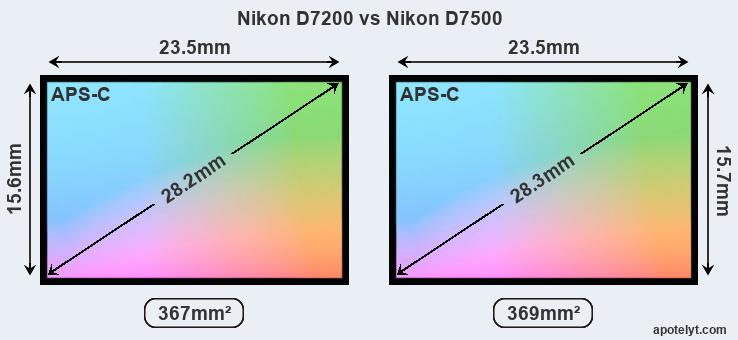
The dimensions of the rear displays on both the D7100 and D7200 are similar. The 3.2-inch display sits flush with the camera body, but the D7500 is more superior because it’s a tilting touchscreen display with angle adjustment during live shooting.
The tilting LCD touchscreen monitor adds versatility to the camera by allowing you to frame your shot better from different angles thanks to the flip-out display, the touchscreen makes it easy to focus with a single tap, and you can choose the tap and shoot setting to capture photos. Furthermore, controlling and viewing the gallery of photos is also easier through a touchscreen monitor.
However, there is a downside to the D7500’s display – screen resolution. D7500 screen has a 922,000-dot resolution while the monitor on D7200 is 1,299,000 dots. Despite the dip in resolution, the screen on the D7500 has good color retention and clarity, which means it is at par with the D7200’s monitor.
Nikon D7200 vs D7500: Build quality
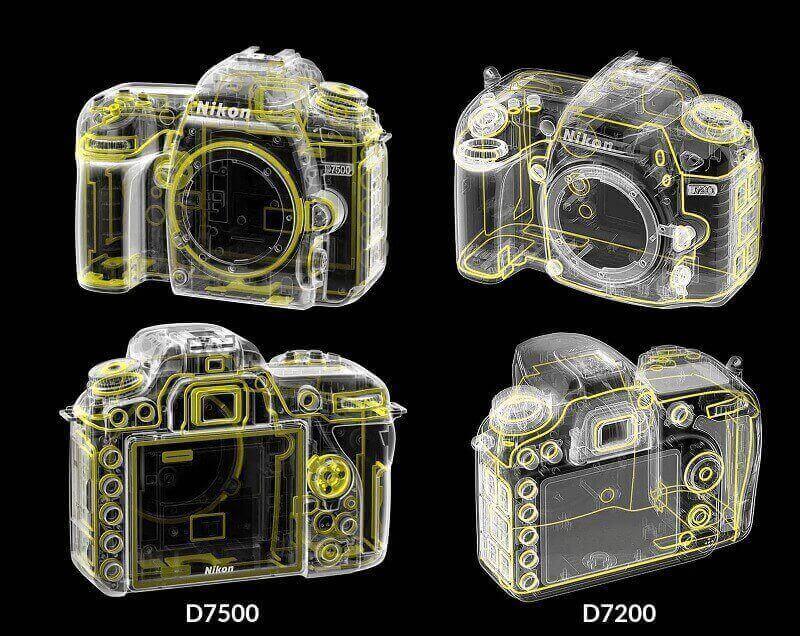
Nikon decided to replace the magnesium alloy panels on the D7200 with carbon fiber construction in the D7500, which makes its 5% lighter than its predecessor as 640g or 1lb 6.6oz. Having said that, the D7500 still feels sturdy and doesn’t feel it’s made from plastic.
The D7500 also features a deeper handgrip, whereas the D7200 has an optional vertical battery grip, which the D7500 lacks.
Nikon D7500 vs D7200: Video
If you are comparing these cameras for their video capabilities for vlogging, then we are happy to say that you can’t go wrong with either one of them, and your choice will solely depend on your budget and needs.
D7200 captures video in upto 60fps Full HD, while the D7500 offers a more modern and up to date output of 30fps 4K footage for up to 30 minutes. That’s not all; you can also reduce the quality to shoot FHD footage at 60fps and timelapse videos in 4K UHD in-camera.
The electronic Vibration Reduction feature in the D7500 will help you produce more stable footage when shooting video then its hand-held. Both cameras have microphone and headphone jacks for improved audio recording and listening. D7500 provides simultaneous output to card and HDMI in 4K UHD.
Nikon D7200 vs D7500: Viewfinder
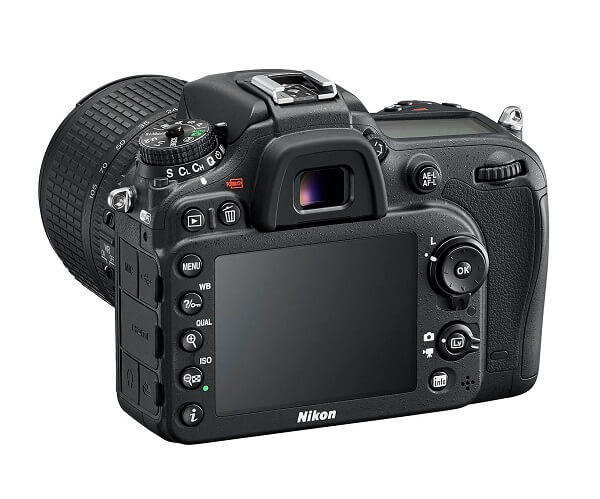
Typically you can locate the viewfinder in the back of the camera, and its purpose is to show the photographer a preview of the frame they are going to capture. It’s a vital tool for framing shots as it gives you greater control and takes the guesswork out.
Both the Nikon D7200 and the Nikon D7500 are fitted with optical viewfinders, as opposed to electronic viewfinders, which need electricity and, therefore, consume battery power that you could use to take pictures. At the same time, the optical viewfinders do not have a negative impact on the battery.
The D7200 and D7200 feature pentaprism optical viewfinders, which are highly advantageous for many reasons compared to pentamirror. Penta Prisms are made from glass and are highly durable; they also allow more light to come into the camera, which results in a brighter, sharper image.
Thanks to the 100 percent protection provided in both cameras, the shots are easier to frame. Although the D7500 and D7200 have many similarities as far as viewfinders are concerned, there is one minor difference. The D7500 viewfinder has a magnification of 0.94x, while the magnification value of the D7200 is 0.91x.
Nikon D7200 vs D7500: Lens Mount and Lens

The Nikon D7200 and Nikon D7500 cameras work with interchangeable lenses that can be mounted on the Nikon F mount used on both devices. The similarities don’t end here, though, because both cameras are compatible with the same number of lenses, which is around 302 different Nikon lenses. This is fantastic because it gives you greater flexibility and choices.
If you are looking into investing in some native lenses, we recommend any enthusiast photographers to go with the Nikon 70-300 millimeter f/4-5.6G Zoom Lens that includes Auto Focus because this lens has an impressive range of 300mm.
Unfortunately, both of the cameras don’t come with built-in picture stabilization, which means you can get a little help from lenses in this department. The 88 optical stabilization lenses by Nikon work with the Nikon F mount.
Nikon D7200 vs D7500: Storage media
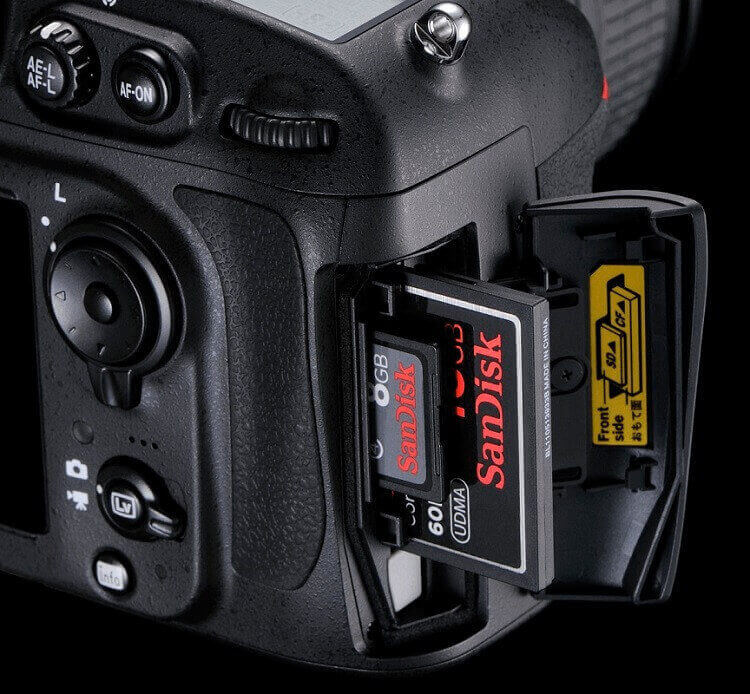
D7200 supports dual SD cards – which means that you can easily set the camera to record different file/media formats on each card. If you wish to record a video and exceptional quality photographs, we would highly recommend D7200 because of its dual SD card support.
On the other hand, D7500 supports only one SD card at a time that may be a huge setback for you if you wish to record on different file formats simultaneously. If you want to record large media files, then a single SD card slot should not be an issue because larger capacity SD cards are now more affordable than ever before.
However, when selecting the best camera according to the storage options, D7200 takes the lead with its dual SD card support.
Nikon D7500 vs D7200: Connectivity
Similar to several other popular Nikon DSLRs, including the D500, D3400, and D850 – the D7500 comes with Nikon’s SnapBridge technology.
SnapBridge technology allows the camera to stay connected to your smart device without any lags. Bluetooth connection or Wi-Fi technology is used to establish a permanent connection between the camera and smart phones. Therefore, you can quickly and conveniently transfer data from the camera to your smartphone whenever you want.
Although D7200 also supports Wi-Fi and NFC connectivity. However, when it comes to a lag-free connection, then D7500 is a better choice.
Nikon D7500 vs D7200: Battery Life
In terms of battery life, the version before this one takes the lead with 1,110 shots per day. While the newer device only offers 950, which is a 13 percent decline. The change is due to the newly built EN-15a battery rather than the long-standing EN-EL15.
Nikon D7500 vs D7200: User Interface & Menus
Both cameras have nearly identical user interfaces and menus. Nevertheless, since the successor has a touchscreen, navigating the menus is far more intuitive. It also allows pinch to zoom and signature attention during playing. In general, these enhancements elevate it to the superior camera category due to its ease of use, something that may be extremely important for new buyers.
Nikon D7500 vs D7200 – The FAQs
Is The Nikon D7200 A Waterproof Camera?
Unfortunately, the Nikon D7200 is not fully waterproof. This camera has a body made from magnesium alloy, giving it a considerably more professional appearance and feel. Therefore, you compromise looks for waterproofing.
The magnesium-alloy material is also weatherproof. This usually indicates that the D7200’s internal components are protected from weather elements such as moisture, dust, and humidity.
It would be best to exercise caution because it can be used in snow, humid, temperate, and wet situations. While weather sealing may protect the camera from such conditions, a single plunge in a body of water may ruin your Nikon D7200.
Is your Nikon D7200 excellent for wildlife photography?
The Nikon D7200 is ideal for nature photography. It is capable of catching birds in flight and even aquatic critters in their natural habitat.
Because of its large buffer, the D7200 can easily capture fast-moving subjects. But shooting in burst mode takes a bit of time for the buffer to fill up. As a result, you’ll have plenty of opportunities to photograph your animal subject.
The D7200 has a reasonable processing rate, which increases focusing accuracy and usefulness. You can easily choose an autofocus target fit for your objectives by using 51 Autofocus points.
The Nikon D7200 sensor does have a high resolution, which is 24 megapixels, a wide dynamic selection, and good control. And its ISO allows users to photograph in a variety of lighting circumstances.
How to transfer photos from my Nikon D7200 to your PC?
Learn how to transfer photos from the Nikon D7200 to your computer below.
- Before you begin, make sure your camera’s battery is fully charged.
- Turn on your computer.
- Turn off your D7200.
- Connect your camera to the USB cord.
- Connect the other end of the USB cord to your computer.
- Please return your Nikon D7200.
- Transferring your photos at this point depends on your PC’s operating system.
- When the move is complete, please turn off your D7200 camera and unplug it from your PC.
Is the Nikon D7500 efficient in low light?
The Nikon D7500 performs admirably in low light. This means it can capture clear photographs in low-light situations. It excels at capturing people in poor light at close range.
The D7500 has the following features that allow it to capture these fantastic images:
- CMOS sensor resolution of 20.9 megapixels.
- ISO ranges from 100 to 51,200. It can be expanded from 32 to 1,638,400 characters.
- ISO of 1 483 for low-light situations (DXO sports).
- A detector performance score of 86 overall.
Nikon D7500 vs D7200: Verdict
It all depends on what you are searching for in a camera! If you are looking for a camera quality similar to D3400 or D5600, the D7500 is the best choice for you.
However, if you are looking for a camera with excellent overall performance, better features, and design, D7200 will surely live up to your expectations.
If you are a D7000 and D7100 user, then D7500 would be an ideal update for you. However, D7200 should skip D7500 and opt for D500 if they are looking for an upgrade.
Read Also

